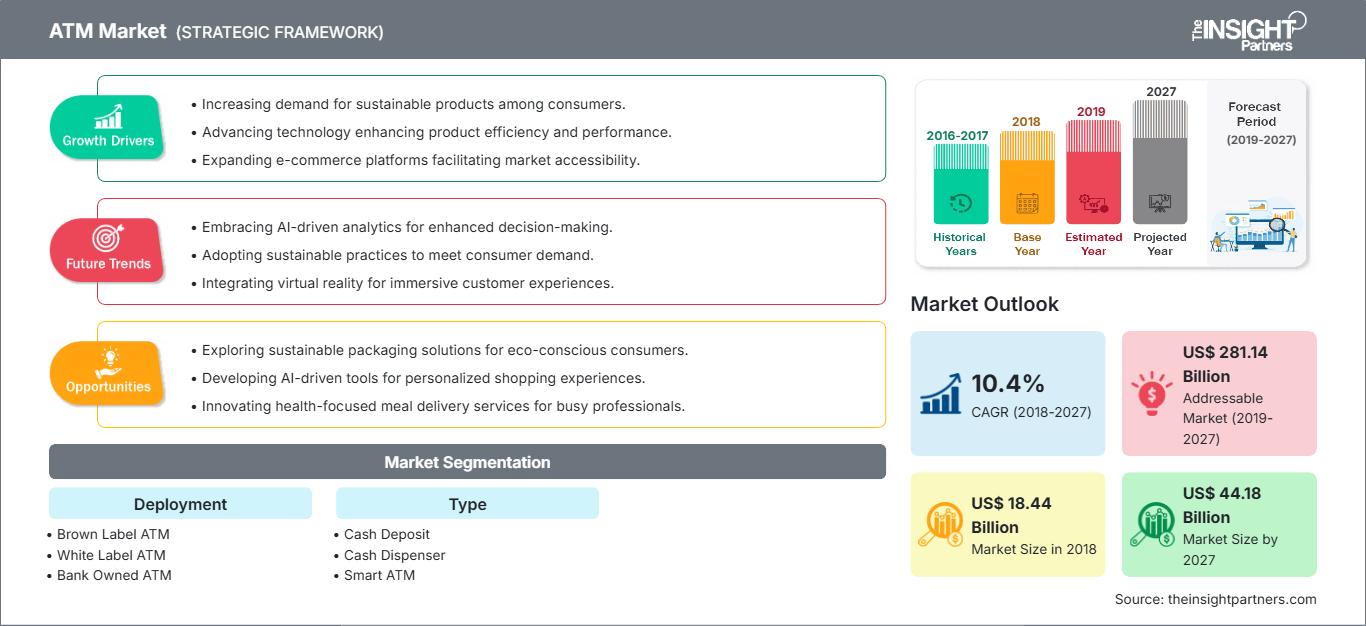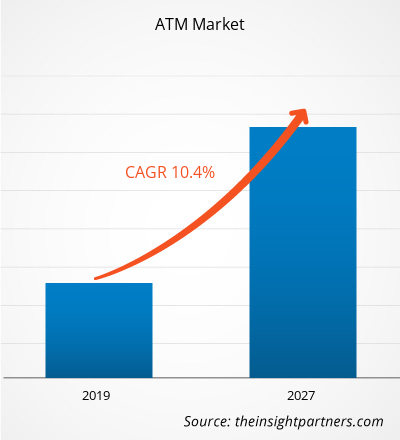Der Geldautomatenmarkt soll von 18,44 Milliarden US-Dollar im Jahr 2018 auf 44,18 Milliarden US-Dollar im Jahr 2027 wachsen, bei einer durchschnittlichen jährlichen Wachstumsrate von 10,4 %.
Der Geldautomatenmarkt wächst aufgrund der steigenden Nachfrage nach Automatisierung im Bankensektor sowohl in Schwellen- als auch in Industrieländern wie den USA, Kanada, Italien und China. Darüber hinaus hat die globale Bankenbranche in den letzten Jahrzehnten bedeutende technische Entwicklungen erlebt, wie die Integration von IoT-Datenanalyse, digitaler Konvergenz sowie Biometrie und Cybersicherheit, die allesamt das Wachstum des Geldautomatenmarktes vorangetrieben haben. Neben Bargeldabhebungen und der Eröffnung von Girokonten ermöglichen Geldautomaten den Verbrauchern, Festgeldkonten zu eröffnen oder abzuheben, Telefonrechnungen aufzuladen, Einkommenssteuer zu zahlen und Privatkredite zu beantragen, was den Komfort erhöht.
Der Geldautomatenmarkt soll sich aufgrund technologischer Verbesserungen wie digitaler Konvergenz, IoT-Datenanalyseintegration, Biometrie und Cybersicherheit weiterentwickeln. Die Integration von erweiterten Sicherheitsmethoden wie Fingerabdruck, Biometrie und doppelter Authentifizierung in technologisch hochentwickelte Geldautomaten bietet zusätzlichen Schutz, der Betrugsprävention und die Akzeptanz von Geldautomaten fördern soll. Ein wichtiger Faktor für die nordamerikanische Geldautomatenbranche ist der wachsende Wunsch nach kartenlosen Transaktionen. Langfristige Geschäftsbeziehungen mit Geschäftspartnern dürften die Umsätze steigern, während neue Innovationstechniken den Geldautomatenanbietern helfen sollen, neue Marktsegmente zu erschließen. Die wachsende Bankeninfrastruktur und die steigende Anzahl von Geldautomaten vor Ort zur Verbesserung der Kundenzufriedenheit dürften das Wachstum des Geldautomatenmarktes vorantreiben.
Passen Sie diesen Bericht Ihren Anforderungen an
Sie erhalten kostenlos Anpassungen an jedem Bericht, einschließlich Teilen dieses Berichts oder einer Analyse auf Länderebene, eines Excel-Datenpakets sowie tolle Angebote und Rabatte für Start-ups und Universitäten.
Geldautomatenmarkt: Strategische Einblicke

- Holen Sie sich die wichtigsten Markttrends aus diesem Bericht.Dieses KOSTENLOSE Beispiel umfasst Datenanalysen, die von Markttrends bis hin zu Schätzungen und Prognosen reichen.
Sie erhalten kostenlos Anpassungen an jedem Bericht, einschließlich Teilen dieses Berichts oder einer Analyse auf Länderebene, eines Excel-Datenpakets sowie tolle Angebote und Rabatte für Start-ups und Universitäten.
Geldautomatenmarkt: Strategische Einblicke

- Holen Sie sich die wichtigsten Markttrends aus diesem Bericht.Dieses KOSTENLOSE Beispiel umfasst Datenanalysen, die von Markttrends bis hin zu Schätzungen und Prognosen reichen.
Einfacher Bargeldfluss, eine wachsende Zahl von Transaktionsvorteilen, schnelle Abhebungen und die praktische Anwendbarkeit von Online- und Offline-Käufen haben die Nutzung von Geldautomaten weltweit vorangetrieben. Aufgrund der Fülle unentdeckter Potenziale weisen die Regionen Asien-Pazifik, Naher Osten und Afrika derzeit ein robustes Entwicklungspotenzial auf. Der Geldautomatenmarkt in Asien-Pazifik und Naher Osten dürfte vom Wirtschaftswachstum und der steigenden Nachfrage nach innovativen interaktiven Geräten in diesen Regionen profitieren.
Einblicke in den Geldautomatenmarkt
Erwarteter Boom bei Videobanking-Technologie
Videobanking ist eine aufstrebende Technologie im Bankwesen, mit der Finanzinstitute wie Banken und Kreditgenossenschaften ihre Mitglieder oder Kunden über Remote-Video-Zusammenarbeit in persönliche Transaktionen einbinden können. Kunden oder Mitglieder können jederzeit und überall mit einem persönlichen Gerät, beispielsweise einem Smartphone, an den Online-Videositzungen teilnehmen. Verschiedene Banken auf der ganzen Welt implementieren Videotechnologie für Geldautomaten, bei denen Kunden per hochauflösender Video-Chat-Technologie mit Full-Service-Bankern in Kontakt treten können. Die Videobanking-Technologie ist benutzerfreundlich und einfach zu bedienen. Kunden können den Bildschirm des Geldautomaten berühren, um die Option „Live-Banking“ auszuwählen. Der Live-Banker erscheint auf dem Bildschirm und unterstützt den Kunden bei Bargeld- oder Scheckeinzahlungen, Kontoabhebungen, Kreditrückzahlungen und Überweisungen. Die mit Videobanking-Technologien ausgestatteten Automaten benötigen weder Debitkarte noch PIN; man kann sicher Geld an einem Video-Banking-Automaten (VTM) abheben. Da der Kunde persönlich mit einem Bankmitarbeiter verbunden ist, können Sicherheitsfragen und ein Lichtbildausweis zur persönlichen Verifizierung implementiert werden.
Markteinblicke nach Einsatz
Der Geldautomat (ATM) ermöglicht es Kunden, Transaktionen ohne die Hilfe eines Bankmitarbeiters abzuschließen. Geldautomaten werden heute für verschiedene Bankgeschäfte genutzt, z. B. für Bargeldabhebungen, Bareinzahlungen, Rechnungszahlungen und die Beschaffung von Kontoauszügen. Weltweit werden verschiedene Arten von Geldautomaten eingesetzt, darunter Brown-Label-Geldautomaten, White-Label-Geldautomaten und bankeigene Geldautomaten. Der Geldautomatenmarkt wurde 2018 nach Einsatzgebiet vom Brown-Label-Segment angeführt.
Regionale Einblicke in den Geldautomatenmarkt
Die Analysten von The Insight Partners haben die regionalen Trends und Faktoren, die den Geldautomatenmarkt im Prognosezeitraum beeinflussen, ausführlich erläutert. In diesem Abschnitt werden auch die Marktsegmente und die geografische Lage in Nordamerika, Europa, dem asiatisch-pazifischen Raum, dem Nahen Osten und Afrika sowie Süd- und Mittelamerika erörtert.
Umfang des Geldautomaten-Marktberichts
| Berichtsattribut | Einzelheiten |
|---|---|
| Marktgröße in 2018 | US$ 18.44 Billion |
| Marktgröße nach 2027 | US$ 44.18 Billion |
| Globale CAGR (2018 - 2027) | 10.4% |
| Historische Daten | 2016-2017 |
| Prognosezeitraum | 2019-2027 |
| Abgedeckte Segmente |
By Bereitstellung
|
| Abgedeckte Regionen und Länder | Nordamerika
|
| Marktführer und wichtige Unternehmensprofile |
|
Dichte der Akteure auf dem Geldautomatenmarkt: Ihre Auswirkungen auf die Geschäftsdynamik verstehen
Der Geldautomatenmarkt wächst rasant. Die steigende Nachfrage der Endnutzer ist auf Faktoren wie veränderte Verbraucherpräferenzen, technologische Fortschritte und ein stärkeres Bewusstsein für die Produktvorteile zurückzuführen. Mit der steigenden Nachfrage erweitern Unternehmen ihr Angebot, entwickeln Innovationen, um den Bedürfnissen der Verbraucher gerecht zu werden, und nutzen neue Trends, was das Marktwachstum weiter ankurbelt.

- Holen Sie sich die Geldautomatenmarkt Übersicht der wichtigsten Akteure
Typbasierte Markteinblicke
Ein Geldautomat ermöglicht Verbrauchern die Durchführung grundlegender Transaktionen mit Debit- oder Kreditkarten. Es handelt sich um ein System, das Geld verarbeitet und Funktionen wie Bargeldeinzahlungen, Bargeldabhebungen und Geldtransfers ausführt. Der Automat besteht aus einem Kartenleser, einem Geldausgabeautomaten und einem Bildschirm, über den der Benutzer relevante Kontostandsinformationen erhält. Im Vergleich zu herkömmlichen Bankschaltern dienen moderne Geldautomaten, wie z. B. intelligente Geldautomaten, als schnelle, bequeme und selbstbedienende Alternative für reibungslose Finanztransaktionen. Der Geldautomatenmarkt wurde, nach Typen gegliedert, vom Geldausgabeautomatensegment angeführt.
Die Akteure auf dem Geldautomatenmarkt verfolgen Strategien wie Fusionen, Übernahmen und Marktinitiativen, um ihre Position auf dem Markt zu behaupten. Nachfolgend sind einige Entwicklungen wichtiger Akteure aufgeführt:
- Im Oktober 2020 kündigte die NCR Corporation die Einführung von NCR Activate Enterprise NextGen an, der Geldautomaten-Softwareplattform der nächsten Generation von NCR, die es Banken ermöglicht, Kundenerlebnisse wie kontaktlose Technologie und Video-Kassierer-Zusammenarbeit auf einfache Weise bereitzustellen.
- Im Jahr 2020 unterzeichnete Diebold Nixdorf einen Vertrag über die Lieferung von 1.800 Geldautomaten an die größte Bank in Saudi-Arabien und 500 Geldautomaten an einen neuen Kunden in Ägypten. Die Unternehmen achten auch darauf, ihre Geräte gegen mögliche Betrugs- und Einbruchsgefahren zu wappnen.
- Historische Analyse (2 Jahre), Basisjahr, Prognose (7 Jahre) mit CAGR
- PEST- und SWOT-Analyse
- Marktgröße Wert/Volumen – Global, Regional, Land
- Branchen- und Wettbewerbslandschaft
- Excel-Datensatz
Aktuelle Berichte
Erfahrungsberichte
Grund zum Kauf
- Fundierte Entscheidungsfindung
- Marktdynamik verstehen
- Wettbewerbsanalyse
- Kundeneinblicke
- Marktprognosen
- Risikominimierung
- Strategische Planung
- Investitionsbegründung
- Identifizierung neuer Märkte
- Verbesserung von Marketingstrategien
- Steigerung der Betriebseffizienz
- Anpassung an regulatorische Trends




















 Kostenlose Probe anfordern für - Geldautomatenmarkt
Kostenlose Probe anfordern für - Geldautomatenmarkt